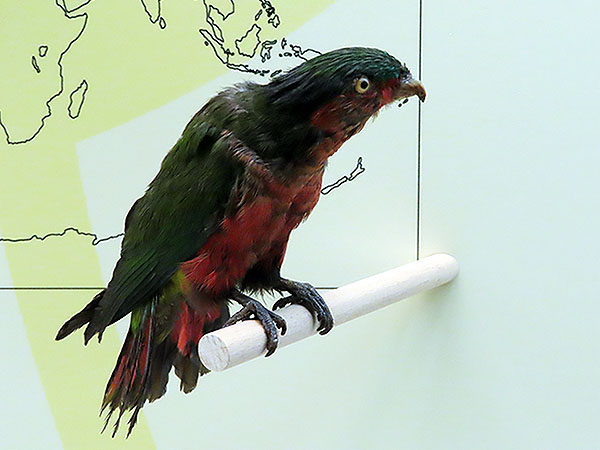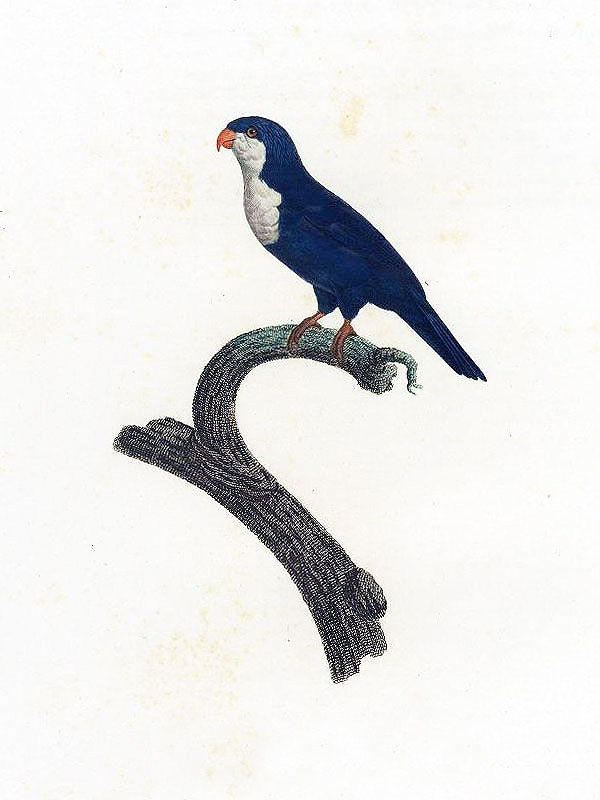“Two species of Kingfishers were common on Bora-Bora (Halcyon veneratus and Todiramphus tutus), ….“
and
“HALCYON VENERATUS. (Ruru.)
This species is fairly common, especially on the island of Bora-Bora.
TODIRAMPHUS TUTUS.
Common throughout the Tahiti group.” [2]
***
These two rather cursory marginal notes from 1907 are an indication of the former existence of a bird species that no longer exists today and of which (almost) no trace can be found today.
***
The Society Islands are one of the very few places where two kingfisher species coexist, at least on the islands of Mo’orea and Tahiti in the eastern part of the archipelago; here you will find the widespread Chattering Kingfisher (Todiramphus tutus (Gmelin)), which occurs throughout the archipelago, as well as the Tahiti Kingfisher (Todiramphus veneratus (Gmelin)) and Moorea Kingfisher (Todiramphus youngi Sharpe), both restricted to a single island each.
However, the two references to the island of Bora Bora indicate that this was apparently also the case on other of the islands.
In fact, the mysterious kingfisher is not only known from small marginal notes but from at least two specimens that were collected at the beginning of the 19th century, one of which apparently still exists. This sole surviving specimen was examined in 2008 and compared to the Tahiti- and Moorea Kingfisher.
The authors concluded that this is an incompletely colored juvenile of the Tahitian species, but also note some differences, including a much shorter beak and some differences in plumage pattern, and conclude that it may also be an extinct subspecies. [3]
The species has also been depicted at least once (see below). [1]
***
Between Bora Bora in the northwestern part of the archipelago and Mo’orea and Tahiti in the eastern part are four other islands, namely Huahine, Mai’ao, Ra’iatea and Taha’a, each of which, at least today, is inhabited only by the Chattering Kingfisher.
If the island of Bora Bora was indeed once home to two species of kingfishers, then this bird must not have been a subspecies of the Tahitian Kingfisher, but a separate species; and, the other islands between Bora Bora and Mo’orea and Tahiti must most likely also have harbored now extinct and unknown distinct species.
***
In my humble opinion, however, the location of Bora Bora is simply an error, and the two birds collected there are more likely to be from the island of Tahiti. … but who knows ….
*********************

Depiction from: ‘M. Lesson: Description du genre Todiramphe et de deux espèces d’oiseaux; qui le compossent. Mémoires de la Société d’Histoire naturelle de Paris 2(3): 419-422. 1827’
(public domain)
*********************
References:
[1] M. L. I. Duperrey: Voyage autour du monde: Exécuté par Ordre du Roi, Sur la Corvette de Sa Majesté, La Coquille, pendant les années 1822, 1823, 1824, et 1825, par M. L. I. Duperrey; Zoologie, par Mm. Lesson et Garnot. Paris: Arthus Bertrand 1828
[2] S. B. Wilson: Notes on birds of Tahiti and the Society group. Ibis Ser. 9(1): 373-379. 1907
[3] Claire Voisin; Jean-François Voisin: List of type specimens of birds in the collections of the Muséum national d’Histoire naturelle (Paris, France). 18. Coraciiformes. Journal of the National Museum (Prague), Natural History Series 177(1): 1-25. 2008
[4] Justin J. F. J. Jansen & Roland E. van der Vliet: The chequered history of the Chattering Kingfisher Todiramphus on Tahiti: I: type specimens. Bulletin of the British Ornithologists’ Club 135(2): 108-120. 2015
[5] Justin J. F. J. Jansen & Roland E. van der Vliet: The chequered history of the Chattering Kingfisher Todiramphus on Tahiti: II: review of status. Bulletin of the British Ornithologists’ Club 135(2): 121-130. 2015
[6] Michael Lee & David T. Holyoak: The chequered history of Chattering Kingfisher Todiramphus tutus on Tahiti: a response. Bulletin of the British Ornithologists’ Club 137(3): 211-217. 2017
[7] Roland E. van der Vliet & Justin J. F. J. Jansen: Reply to Lee & Holyoak: how definite are 20th-cetury reports of Chattering Kingfisher Todiramphus tutus from Tahiti? Bulletin of the British Ornithologists’ Club 137(3): 218-225. 2017
*********************
edited: 06.07.2023


